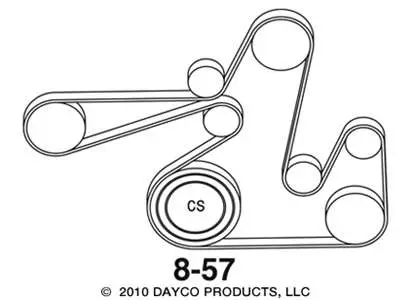The V-belt is a unique belt used to start the auxiliary units of the SUS engine, such as the alternator, servo pump, water pump, and air conditioning compressor.
In the past, cars had multiple individual belts connecting different parts. Considering that each personal belt could cause other problems, as well as the fact that, as a result, the vehicle’s performance was reduced, the vehicle manufacturers made one belt that connected several parts.
How often do I need to replace the V-belt?
Belts of this type are made “in the long run.” Under ideal conditions, a belt can last an average of 60,000 to 100,000 km. Impressive. However, some belts require adjustment and regular inspection. Otherwise, your vehicle will remain “out of the machine if the belt breaks.”
How many belts does the vehicle have?
Today, most vehicles have only one belt—a V-belt. Before this all-in-one solution, cars had several belts connecting individual parts and components into one functional unit.
What does the Dodge Avenger 2.4 belt diagram look like?
The 2013 Dodge Avenger 2.4 belt diagram, 2014 Dodge Avenger 2.4 l serpentine belt diagram, and 2008 Dodge Avenger serpentine belt diagram look like in the image below:
What is the “working life” of a V-belt?
Like all other parts of the system, V-belts have a lifespan. They can break or wear out. If you hear a squeak or the belt slips, it is a sure sign that the belt is worn out and should be replaced.
Advantages of regular maintenance and replacement
Driving with a worn-out belt is a potential traveling disaster. If the belt breaks or slips, all parts—starting from the alternator via the servo pump and the cooling device—stop working, and as a result, they can suffer some damage. Regular belt replacement reduces the risk of significant failures and injury in these cases.
Symptoms that may lead to a belt replacement
Squeak: If the belt slips, an unpleasant whistling sound is usually heard because the belt and pulley no longer function together properly, leading to damage and ultimate cracking. If these sounds occur, taking the vehicle for inspection as soon as possible is necessary to prevent additional breakdowns.
Reduced performance: If the belt is damaged, problems and malfunctions in the alternator, water pump, cooling system, etc., are highly probable. Failures of this type can be costly and can blow the budget.
Engine light: A warning light can signify something wrong with the belt.
Fact: If the V-belt is loose, you may encounter reduced water pump operation, which can result in motor overheating. To avoid potential problems and performance loss, bring your vehicle to Trio Service, and we will take care of everything.
Strange noises can also signify potential problems with other vehicle parts, so don’t ignore them.

